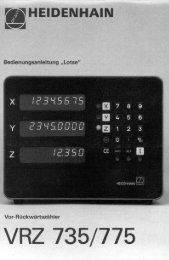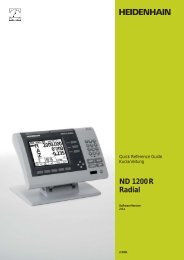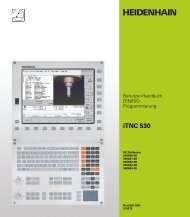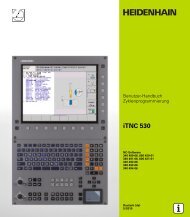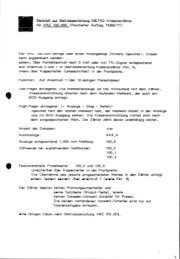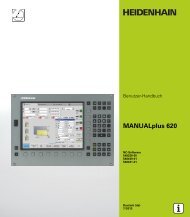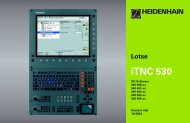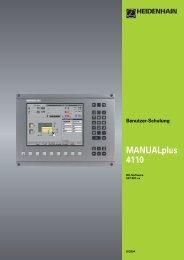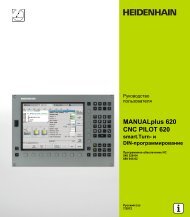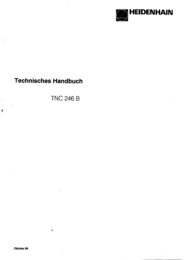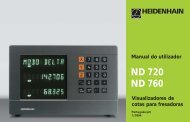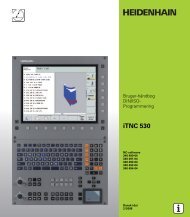- Page 1 and 2:
Manuale d’esercizio Programmazion
- Page 5 and 6:
Tipo di TNC, software e funzioni Il
- Page 7 and 8:
Opzione software lingua di dialogo
- Page 9 and 10:
Unzioni FCL 2 Descrizione Filtraggi
- Page 11 and 12:
Nuove funzioni 340 49x-02 „ Ora i
- Page 13 and 14:
Funzioni modificate 340 49x-01 risp
- Page 15:
Funzioni modificate 340 49x-03 „
- Page 19 and 20:
1 Introduzione ..... 43 1.1 Il iTNC
- Page 21 and 22:
3 Posizionamento con inserimento ma
- Page 23 and 24:
4.5 Grafica di programmazione .....
- Page 25 and 26:
5 Programmazione: Utensili ..... 17
- Page 27 and 28:
7 Programmazione: Funzioni ausiliar
- Page 29 and 30:
8 Programmazione: Cicli ..... 281 8
- Page 31 and 32:
8.9 Cicli per la conversione di coo
- Page 33 and 34:
10 Programmazione: Sottoprogrammi e
- Page 35 and 36:
11.10 Parametri Q preprogrammati ..
- Page 37 and 38:
12.9 Controllo adattativo dell’av
- Page 39 and 40:
13.14 Limitazione delle corse, visu
- Page 41:
15 iTNC 530 con Windows 2000 (opzio
- Page 44 and 45:
1.1 Il iTNC 530 1.1 Il iTNC 530 I T
- Page 46 and 47:
1.2 Unità video e tastiera Definiz
- Page 48 and 49:
1.3 Modi operativi 1.3 Modi operati
- Page 50 and 51:
1.3 Modi operativi Esecuzione conti
- Page 52 and 53:
1.4 Visualizzazioni di stato Simbol
- Page 54 and 55:
1.4 Visualizzazioni di stato Panora
- Page 56 and 57:
1.4 Visualizzazioni di stato Posizi
- Page 58 and 59:
1.4 Visualizzazioni di stato Impost
- Page 60 and 61:
1.5 Accessori: Sistemi di tastatura
- Page 63 and 64:
2 Funzionamento manuale e allineame
- Page 65 and 66:
Se la macchina è equipaggiata con
- Page 67 and 68:
2.2 Spostamento assi macchina Avver
- Page 69 and 70:
Spostamento con il volantino elettr
- Page 71 and 72:
Display Il display del volantino (v
- Page 73 and 74:
Posizionamento incrementale Nel pos
- Page 75 and 76:
Funzioni nei modi operativi di esec
- Page 77 and 78:
Modifica giri mandrino e avanzament
- Page 79 and 80:
Impostazione dell’origine con i t
- Page 81 and 82:
Esistono più possibilità per memo
- Page 83 and 84:
Funzione Softkey Confermare diretta
- Page 85 and 86:
Modifica della tabella Preset Funzi
- Page 87 and 88:
2.5 Rotazione del piano di lavoro (
- Page 89 and 90:
Determinazione dell’origine nel s
- Page 91 and 92:
Attivazione della rotazione manuale
- Page 93 and 94:
2.6 Controllo anticollisione dinami
- Page 95:
Controllo anticollisione nel funzio
- Page 98 and 99:
3.1 Programmazione ed esecuzione di
- Page 100 and 101:
3.1 Programmazione ed esecuzione di
- Page 103 and 104:
4 Programmazione: Generalità, gest
- Page 105 and 106:
Sistema di riferimento sulle fresat
- Page 107 and 108:
Posizioni assolute e incrementali d
- Page 109 and 110:
4.2 Gestione file dati Generalità
- Page 111 and 112:
4.3 Operare con la gestione file da
- Page 113 and 114:
Chiamata Gestione file dati Premere
- Page 115 and 116:
Passo 3: selezione file dati 4*.H P
- Page 117 and 118:
Copiatura di un singolo file 8 Port
- Page 119 and 120:
Copiatura directory Portare il camp
- Page 121 and 122:
Selezione di file dati Funzioni di
- Page 123 and 124:
Trasmissione dati a/da un supporto
- Page 125 and 126:
Copiatura di file dati in un’altr
- Page 127 and 128:
Dispositivi USB sul TNC (funzione F
- Page 129 and 130:
Apertura di un nuovo programma di l
- Page 131 and 132:
Programmazione movimento utensili P
- Page 133 and 134:
Editing di un programma Un programm
- Page 135 and 136:
Ricerca istruzioni uguali in vari b
- Page 137 and 138:
La funzione di ricerca del TNC Con
- Page 139 and 140:
4.5 Grafica di programmazione Esecu
- Page 141 and 142:
4.6 Grafica di linea 3D (funzione F
- Page 143 and 144:
Funzione Softkey Visualizza/non vis
- Page 145 and 146:
4.7 Strutturazione dei programmi De
- Page 147 and 148:
4.9 Generazione di file dati di tes
- Page 149 and 150:
Cancellazione e reinserimento di ca
- Page 151 and 152:
Ricerca di parti di testo Con la fu
- Page 153 and 154:
4.11 Aiuto diretto per messaggi d
- Page 155 and 156: Contenuto della finestra Colonna Si
- Page 157 and 158: Lavoro con TNCguide Chiamata di TNC
- Page 159 and 160: Funzione Softkey „ Indice a sinis
- Page 161 and 162: Download dei file di aiuto aggiorna
- Page 163 and 164: 4.14 Gestione dei pallet Impiego La
- Page 165 and 166: Funzione di editing Softkey Cancell
- Page 167 and 168: 4.15 Funzionamento con pallet con l
- Page 169 and 170: „ SP-X, SP-Y, SP-Z (introduzione
- Page 171 and 172: Funzioni di editing per modelli Sof
- Page 173 and 174: Impostazione del livello pallet „
- Page 175 and 176: Impostazione del livello pezzo „
- Page 177 and 178: „ Se tutti i pezzi all’interno
- Page 179 and 180: 5 Programmazione: Utensili HEIDENHA
- Page 181 and 182: 5.2 Dati utensile Premesse per la c
- Page 183 and 184: Inserimento dei dati utensile nelle
- Page 185 and 186: Tabella utensili: dati utensile per
- Page 187 and 188: Editing delle tabelle utensili La t
- Page 189 and 190: Sovrascrittura di singoli dati uten
- Page 191 and 192: Selezione tabella posti nel modo op
- Page 193 and 194: Chiamata dei dati utensile Una chia
- Page 195 and 196: Cambio utensile automatico in caso
- Page 197 and 198: Correzione del raggio dell’utensi
- Page 199 and 200: Correzione del raggio: lavorazione
- Page 201 and 202: 5.5 Lavoro con tabelle dati di tagl
- Page 203 and 204: Tabella per materiali taglienti I m
- Page 205: Procedura per il lavoro con il calc
- Page 209 and 210: Programmazione: Programmazione prof
- Page 211 and 212: 6.2 Generalità relative alle funzi
- Page 213 and 214: Correzione del raggio La correzione
- Page 215 and 216: Punto finale Condizioni per la scel
- Page 217 and 218: Esempi di blocchi NC N50 G00 G40 G9
- Page 219 and 220: Retta in rapido G00 Retta con avanz
- Page 221 and 222: Arrotondamento di spigoli G25 Con l
- Page 223 and 224: Traiettoria circolare G02/G03/G05 i
- Page 225 and 226: Angolo al centro CCA e raggio dell
- Page 227 and 228: Esempio: Traiettoria lineare e smus
- Page 229 and 230: N170 G01 X+5 * Posizionamento sull
- Page 231 and 232: 6.5 Traiettorie - Coordinate polari
- Page 233 and 234: Traiettoria circolare G16 con racco
- Page 235 and 236: Esempio: Traiettoria lineare con co
- Page 237 and 238: N110 G98 L1 * Inizio della ripetizi
- Page 239 and 240: Apertura di un file DXF 8 Seleziona
- Page 241 and 242: Impostazione dei layer I file DXF c
- Page 243 and 244: Selezione dell’origine su un sing
- Page 245 and 246: 8 Salvare gli elementi di profilo s
- Page 247: Funzione Zoom Per riconoscere facil
- Page 250 and 251: 7.1 Funzioni ausiliarie M e G38 e r
- Page 252 and 253: 7.3 Funzioni ausiliarie per indicaz
- Page 254 and 255: 7.3 Funzioni ausiliarie per indicaz
- Page 256 and 257:
7.4 Funzioni ausiliarie per traiett
- Page 258 and 259:
7.4 Funzioni ausiliarie per traiett
- Page 260 and 261:
7.4 Funzioni ausiliarie per traiett
- Page 262 and 263:
7.4 Funzioni ausiliarie per traiett
- Page 264 and 265:
7.4 Funzioni ausiliarie per traiett
- Page 266 and 267:
7.4 Funzioni ausiliarie per traiett
- Page 268 and 269:
7.4 Funzioni ausiliarie per traiett
- Page 270 and 271:
7.5 Funzioni ausiliarie per assi di
- Page 272 and 273:
7.5 Funzioni ausiliarie per assi di
- Page 274 and 275:
7.5 Funzioni ausiliarie per assi di
- Page 276 and 277:
7.5 Funzioni ausiliarie per assi di
- Page 278 and 279:
7.6 Funzioni ausiliarie per macchin
- Page 281 and 282:
Programmazione: Cicli 8 HEIDENHAIN
- Page 283 and 284:
Definizione dei cicli tramite softk
- Page 285 and 286:
Chiamata di un ciclo Premesse Prima
- Page 287 and 288:
Lavorazione con gli assi ausiliari
- Page 289 and 290:
Mascheratura di singoli punti per l
- Page 291 and 292:
Modo di funzionamento delle tabelle
- Page 293 and 294:
Ciclo Softkey Pag. G209 MASCHIATURA
- Page 295 and 296:
8 DISTANZA DI SICUREZZA Q200 (in va
- Page 297 and 298:
8 DISTANZA DI SICUREZZA Q200 (in va
- Page 299 and 300:
8 DISTANZA DI SICUREZZA Q200 (in va
- Page 301 and 302:
8 DISTANZA DI SICUREZZA Q200 (in va
- Page 303 and 304:
8 DISTANZA DI SICUREZZA Q200 (in va
- Page 305 and 306:
8 DISTANZA DI SICUREZZA Q200 (in va
- Page 307 and 308:
FORATURA PROFONDA UNIVERSALE (Ciclo
- Page 309 and 310:
8 PROFONDITA’ FORO FINO A ROTTURA
- Page 311 and 312:
8 DISTANZA DI SICUREZZA Q200 (in va
- Page 313 and 314:
8 DISTANZA DI SICUREZZA Q200 (in va
- Page 315 and 316:
8 DISTANZA DI SICUREZZA Q200 (in va
- Page 317 and 318:
Con il parametro macchina 7441 Bit
- Page 319 and 320:
Generalità sulla fresatura di file
- Page 321 and 322:
FRESATURA DI FILETTATURE (Ciclo G26
- Page 323 and 324:
FRESATURA DI FILETTATURE CON SMUSSO
- Page 325 and 326:
8 DIAMETRO NOMINALE Q335: diametro
- Page 327 and 328:
FRESATURA DI FILETTATURE CON PREFOR
- Page 329 and 330:
8 DIAMETRO NOMINALE Q335: diametro
- Page 331 and 332:
FRESATURA DI FILETTATURE ELICOIDALE
- Page 333 and 334:
8 DIAMETRO NOMINALE Q335: diametro
- Page 335 and 336:
FRESATURA DI FILETTATURE ESTERNE (C
- Page 337 and 338:
8 DIAMETRO NOMINALE Q335: diametro
- Page 339 and 340:
Esempio: Cicli di foratura %C200 G7
- Page 341 and 342:
Esempio: Cicli di foratura Esecuzio
- Page 343 and 344:
N100 G79 „PAT“ F5000 M3 * Chiam
- Page 345 and 346:
TASCA RETTANGOLARE (ciclo G251) Con
- Page 347 and 348:
8 TIPO DI LAVORAZIONE (0/1/2) Q215:
- Page 349 and 350:
8 Fattore di sovrapposizione traiet
- Page 351 and 352:
Finitura 5 Se le maggiorazioni per
- Page 353 and 354:
8 DISTANZA DI SICUREZZA Q200 (in va
- Page 355 and 356:
Finitura 4 Se i sovrametalli per fi
- Page 357 and 358:
8 PROFONDITA’ Q201 (in valore inc
- Page 359 and 360:
SCANALATURA CIRCOLARE (ciclo 254) C
- Page 361 and 362:
8 TIPO DI LAVORAZIONE (0/1/2) Q215:
- Page 363 and 364:
8 DISTANZA DI SICUREZZA Q200 (in va
- Page 365 and 366:
8 DISTANZA DI SICUREZZA Q200 (in va
- Page 367 and 368:
8 DISTANZA DI SICUREZZA Q200 (in va
- Page 369 and 370:
8 DISTANZA DI SICUREZZA Q200 (in va
- Page 371 and 372:
8 DISTANZA DI SICUREZZA Q200 (in va
- Page 373 and 374:
Con il parametro macchina 7441 Bit
- Page 375 and 376:
SCANALATURA CIRCOLARE (asola) penet
- Page 377 and 378:
8 ANGOLO DI PARTENZA Q245 (in valor
- Page 379 and 380:
N80 G79 M03 * Chiamata del ciclo "L
- Page 381 and 382:
8.5 Cicli per la definizione di sag
- Page 383 and 384:
8 ANGOLO INCREMENTALE Q247 (in valo
- Page 385 and 386:
8 PUNTO DI PARTENZA 1º ASSE Q225 (
- Page 387 and 388:
N70 G220 CERCHIO SAGOME Definizione
- Page 389 and 390:
Caratteristiche dei cicli di lavora
- Page 391 and 392:
PROFILO (Ciclo G37) Nel ciclo G37 P
- Page 393 and 394:
"Somma" delle superfici E’ richie
- Page 395 and 396:
DATI PROFILO (Ciclo G120) Nel ciclo
- Page 397 and 398:
SVUOTAMENTO (Ciclo G122) 1 Il TNC p
- Page 399 and 400:
FINITURA DEL FONDO (Ciclo G123) Il
- Page 401 and 402:
PROFILO SAGOMATO (Ciclo G125) Con q
- Page 403 and 404:
SUPERFICIE CILINDRICA (Ciclo G127,
- Page 405 and 406:
FRESATURA DI SCANALATURE SU SUPERFI
- Page 407 and 408:
FRESATURA DI ISOLA SU SUPERFICIE CI
- Page 409 and 410:
FRESATURA DI PROFILO ESTERNO SU SUP
- Page 411 and 412:
Esempio: Preforatura, sgrossatura,
- Page 413 and 414:
N200 G98 L1 * Sottoprogramma 1 del
- Page 415 and 416:
N100 G98 L1 * Sottoprogramma del pr
- Page 417 and 418:
N90 G98 L1 * Sottoprogramma del pro
- Page 419 and 420:
N100 G98 L1 * Sottoprogramma del pr
- Page 421 and 422:
„ Nella rifinitura laterale il TN
- Page 423 and 424:
Profili sovrapposti Fondamentalment
- Page 425 and 426:
"Differenza" delle superfici E’ r
- Page 427 and 428:
N90 G122 SVUOTAMENTO Definizione de
- Page 429 and 430:
8.8 Cicli di spianatura Panoramica
- Page 431 and 432:
SPIANATURA (Ciclo G230) 1 Il TNC po
- Page 433 and 434:
SUPERFICIE REGOLARE (Ciclo G231) 1
- Page 435 and 436:
8 4º PUNTO 1º ASSE Q234 (in valor
- Page 437 and 438:
Strategia Q389=1 3 Successivamente
- Page 439 and 440:
8 Strategia di lavorazione (0/1/2)
- Page 441 and 442:
8 DISTANZA DI SICUREZZA Q200 (in va
- Page 443 and 444:
8.9 Cicli per la conversione di coo
- Page 445 and 446:
Spostamento dell’ORIGINE con tabe
- Page 447 and 448:
Funzione Softkey Conferma della rig
- Page 449 and 450:
LAVORAZIONE SPECULARE (Ciclo G28) C
- Page 451 and 452:
ROTAZIONE (Ciclo G73) Nell'ambito d
- Page 453 and 454:
PIANO DI LAVORO (ciclo G80, opzione
- Page 455 and 456:
Posizionamento asse di rotazione Il
- Page 457 and 458:
Breve guida per il lavoro con il ci
- Page 459 and 460:
Esempio: cicli per la conversione d
- Page 461 and 462:
8.10 Cicli speciali TEMPO DI SOSTA
- Page 463 and 464:
ORIENTAMENTO DEL MANDRINO (Ciclo G3
- Page 465 and 466:
Effetti sulla definizione geometric
- Page 467:
HEIDENHAIN iTNC 530 467 8.10 Cicli
- Page 470 and 471:
9.1 La funzione PLANE: Rotazione de
- Page 472 and 473:
9.1 La funzione PLANE: Rotazione de
- Page 474 and 475:
9.2 Definizione del piano di lavoro
- Page 476 and 477:
9.3 Definizione del piano di lavoro
- Page 478 and 479:
9.4 Definizione del piano di lavoro
- Page 480 and 481:
9.5 Definizione del piano di lavoro
- Page 482 and 483:
9.6 Definizione del piano di lavoro
- Page 484 and 485:
9.7 Definizione del piano di lavoro
- Page 486 and 487:
9.8 Piano di lavoro tramite angolo
- Page 488 and 489:
9.9 Definizione del comportamento n
- Page 490 and 491:
9.9 Definizione del comportamento n
- Page 492 and 493:
9.9 Definizione del comportamento n
- Page 495 and 496:
10 Programmazione: Sottoprogrammi e
- Page 497 and 498:
10.2 Sottoprogrammi Principio di fu
- Page 499 and 500:
10.4 Programma qualsiasi quale sott
- Page 501 and 502:
10.5 Annidamenti Tipi di annidament
- Page 503 and 504:
Ripetizione di un sottoprogramma Es
- Page 505 and 506:
N90 G98 L1 * LABEL per la ripetizio
- Page 507 and 508:
N70 X+15 Y+10 M3 * Posizionamento s
- Page 509:
N100 G00 Z+250 M6 * Cambio utensile
- Page 512 and 513:
11.1 Principio e panoramica delle f
- Page 514 and 515:
11.1 Principio e panoramica delle f
- Page 516 and 517:
11.3 Definizione di profili mediant
- Page 518 and 519:
11.3 Definizione di profili mediant
- Page 520 and 521:
11.4 Funzioni trigonometriche (Trig
- Page 522 and 523:
11.5 Decisioni se/allora con i para
- Page 524 and 525:
11.7 Altre funzioni 11.7 Altre funz
- Page 526 and 527:
11.7 Altre funzioni Numero errore M
- Page 528 and 529:
11.7 Altre funzioni Numero errore M
- Page 530 and 531:
11.8 Introduzione diretta di formul
- Page 532 and 533:
11.8 Introduzione diretta di formul
- Page 534 and 535:
11.9 Parametri stringa 11.9 Paramet
- Page 536 and 537:
11.9 Parametri stringa Conversione
- Page 538 and 539:
11.9 Parametri stringa Conversione
- Page 540 and 541:
11.9 Parametri stringa Determinazio
- Page 542 and 543:
11.10 Parametri Q preprogrammati 11
- Page 544 and 545:
11.10 Parametri Q preprogrammati Al
- Page 546 and 547:
11.10 Parametri Q preprogrammati Ri
- Page 548 and 549:
11.11 Esempi di programmazione 11.1
- Page 550 and 551:
11.11 Esempi di programmazione Esem
- Page 552 and 553:
11.11 Esempi di programmazione Esem
- Page 555 and 556:
12 Test ed esecuzione del programma
- Page 557 and 558:
Impostazione della velocità di tes
- Page 559 and 560:
Rappresentazione su 3 piani Questa
- Page 561 and 562:
Rotazione e ingrandimento/riduzione
- Page 563 and 564:
Ingrandimento di dettagli I dettagl
- Page 565 and 566:
Calcolo del tempo di lavorazione Mo
- Page 567 and 568:
12.3 Test del programma Impiego Nel
- Page 569 and 570:
Esecuzione Test del programma fino
- Page 571 and 572:
Interruzione della lavorazione Esis
- Page 573 and 574:
Spostamento degli assi della macchi
- Page 575 and 576:
Rientro nel programma ad un numero
- Page 577 and 578:
Riposizionamento sul profilo Con la
- Page 579 and 580:
Colonna Significato TNR Numero di u
- Page 581 and 582:
12.6 Salto di blocchi Impiego I blo
- Page 583 and 584:
12.8 Impostazioni globali di progra
- Page 585 and 586:
Se si attivano contemporaneamente p
- Page 587 and 588:
Spostamento di origine additivo, ag
- Page 589 and 590:
Override volantino Con la funzione
- Page 591 and 592:
L’impiego del controllo adattativ
- Page 593 and 594:
Colonna Funzione POUT Potenza del m
- Page 595 and 596:
Prima di eseguire un taglio di appr
- Page 597 and 598:
Attivazione/disattivazione AFC 8 Se
- Page 599:
Il TNC determina il tempo di lavora
- Page 602 and 603:
13.1 Selezione funzioni MOD 13.1 Se
- Page 604 and 605:
13.2 Numeri software 13.2 Numeri so
- Page 606 and 607:
13.4 Caricamento di Service Pack 13
- Page 608 and 609:
13.5 Programmazione interfacce dati
- Page 610 and 611:
13.5 Programmazione interfacce dati
- Page 612 and 613:
13.6 Interfaccia Ethernet Collegame
- Page 614 and 615:
13.6 Interfaccia Ethernet Configura
- Page 616 and 617:
13.6 Interfaccia Ethernet Impostazi
- Page 618 and 619:
13.6 Interfaccia Ethernet Controllo
- Page 620 and 621:
13.7 Configurazione del PGM MGT Fil
- Page 622 and 623:
13.9 Rappresentazione pezzo grezzo
- Page 624 and 625:
13.10 Selezione dell’indicazione
- Page 626 and 627:
13.12 Selezione della lingua di pro
- Page 628 and 629:
13.14 Limitazione delle corse, visu
- Page 630 and 631:
13.15 Esecuzione della funzione HEL
- Page 632 and 633:
13.17 Impostazione ora di sistema 1
- Page 634 and 635:
13.19 Accesso esterno 13.19 Accesso
- Page 636 and 637:
14.1 Parametri utente generali 14.1
- Page 638 and 639:
14.1 Parametri utente generali Sist
- Page 640 and 641:
14.1 Parametri utente generali Sist
- Page 642 and 643:
14.1 Parametri utente generali Visu
- Page 644 and 645:
14.1 Parametri utente generali Visu
- Page 646 and 647:
14.1 Parametri utente generali Visu
- Page 648 and 649:
14.1 Parametri utente generali Visu
- Page 650 and 651:
14.1 Parametri utente generali Lavo
- Page 652 and 653:
14.2 Piedinatura del connettore e c
- Page 654 and 655:
14.2 Piedinatura del connettore e c
- Page 656 and 657:
14.3 Scheda tecnica Funzioni utente
- Page 658 and 659:
14.3 Scheda tecnica Dati tecnici Te
- Page 660 and 661:
14.3 Scheda tecnica Opzione softwar
- Page 662 and 663:
14.4 Sostituzione batteria tampone
- Page 664 and 665:
15.1 Introduzione 15.1 Introduzione
- Page 666 and 667:
15.2 Avvio dell’applicazione iTNC
- Page 668 and 669:
15.3 Disinserimento del iTNC 530 15
- Page 670 and 671:
15.3 Disinserimento del iTNC 530 Di
- Page 672 and 673:
15.4 Impostazioni di rete Controllo
- Page 674 and 675:
15.5 Particolarità nella Gestione
- Page 676 and 677:
Index E Ellisse ... 548 Esecuzione
- Page 678 and 679:
Index S Sistema di aiuto ... 156 Si
- Page 680 and 681:
M Attivazione Attivo a Inizio Fine
- Page 682 and 683:
Funzioni G Traiettorie utensile G00
- Page 684 and 685:
Indirizzi R R R R S S T T T U V W X



